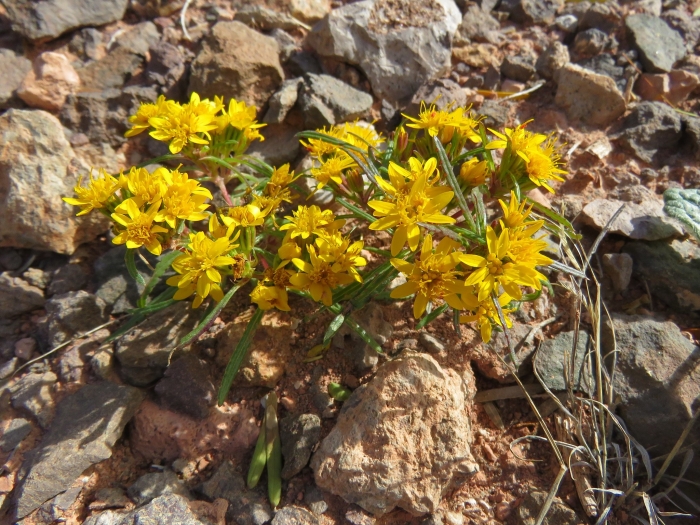Lemonscented Cinchweed
(Pectis angustifolia)
Lemonscented Cinchweed (Pectis angustifolia)
/
/

Annika Lindqvist
CC BY 4.0
Image By:
Annika Lindqvist
Recorded By:
Copyright:
CC BY 4.0
Copyright Notice:
Photo by: Annika Lindqvist | License Type: CC BY 4.0 | License URL: http://creativecommons.org/licenses/by/4.0/ | Rights Holder: Annika Lindqvist | Publisher: iNaturalist | Date Created: 2018-12-15T14:30:46-08:00 |

























Estimated Native Range
Summary
Pectis angustifolia, commonly known as lemonscented cinchweed, is an annual herb that is native to the desert grasslands and scrublands of the southwestern United States and northern Mexico, including regions from Nebraska and Colorado to Arizona. It typically grows to a height of 4-12 inches (10-30 cm) and spreads to form a low mat. The plant is characterized by its narrow, linear leaves and small, yellow, daisy-like flowers that bloom from July to October. The flowers are modest in size but can be quite numerous, creating a noticeable display in its native arid landscapes. The foliage emits a strong lemon scent when crushed, which is where the common name originates.
Lemonscented cinchweed is valued for its drought tolerance and ability to thrive in hot, sunny locations with dry, gravelly soils. It is often used in xeriscaping and as a ground cover in rock gardens or desert-themed landscapes. While it cannot grow in the shade, it is well-suited to full sun conditions and requires minimal water once established. In traditional medicine, the crushed leaves of Pectis angustifolia are used by indigenous peoples, such as the Hopi, to treat stomach aches, and the plant is also consumed boiled with green corn, known as taichima. However, gardeners should be aware that it may self-seed prolifically under ideal conditions, which could lead to unwanted spread in the garden.CC BY-SA 4.0
Lemonscented cinchweed is valued for its drought tolerance and ability to thrive in hot, sunny locations with dry, gravelly soils. It is often used in xeriscaping and as a ground cover in rock gardens or desert-themed landscapes. While it cannot grow in the shade, it is well-suited to full sun conditions and requires minimal water once established. In traditional medicine, the crushed leaves of Pectis angustifolia are used by indigenous peoples, such as the Hopi, to treat stomach aches, and the plant is also consumed boiled with green corn, known as taichima. However, gardeners should be aware that it may self-seed prolifically under ideal conditions, which could lead to unwanted spread in the garden.CC BY-SA 4.0
Plant Description
- Plant Type: Herb
- Height: 0.5-1 feet
- Width: 0.5-1 feet
- Growth Rate: Moderate
- Flower Color: Yellow
- Flowering Season: Spring, Summer, Fall
- Leaf Retention:
Growth Requirements
- Sun: Full Sun, Part Shade
- Water: Low
- Drainage: Fast, Medium
Common Uses
Drought Tolerant, Fragrant, Low Maintenance
Natural Habitat
Native to the desert grasslands and scrublands of the southwestern United States and northern Mexico
Other Names
Common Names: Lemon-scented Cinchweed, Crownseed Pectis, Lemonscent, Narrowleaf Pectis, Lemon-scented Pectis
Scientific Names: , Pectis angustifolia, Helioreos angustifolius, Pectidopsis angustifolia, Pectis angustifolia var. subaristata, Pectis papposa var. sessilis,
GBIF Accepted Name: